How Long Does Spelt Last?
Shelf Life and Storage Tips
Spelt (how long does spelt last?), an ancient grain related to wheat, is prized for its nutty flavor and high protein content. As with many whole grains, its shelf life is an important consideration for consumers and producers alike. Typically, spelt can last quite a while if stored under the right conditions, due to its natural protective outer husk which keeps the grain preserved. Once processed into flour, however, spelt's shelf life is reduced, although it still maintains a respectable duration when stored properly.
To maximize longevity, spelt grains should be kept in a cool, dry environment, and when stored properly, whole spelt grains can remain fresh for several months, and even up to a year if kept in a freezer. Spelt flour (how long does spelt flour last?), on the other hand, tends to have a shorter shelf life due to its increased exposure to air and moisture following milling. Typically, spelt flour can last up to six months when stored in an airtight container away from varying temperatures and strong odors, which can impact its quality.
It is essential for consumers to be aware of the signs of spoilage, such as changes in smell, taste, or appearance, to avoid using grains or flour that may have gone bad. Knowing the expected shelf life of spelt ensures both safety and enjoyment of this nutritious grain.
Understanding Spelt
Spelt is an ancient whole grain, known for its nutty flavor and a host of nutritional benefits. It is closely related to wheat and is often sought after for its use in healthier baking alternatives.
Botanical Profile
Spelt (Triticum spelta) belongs to the same family as wheat (Triticum aestivum), but they are separate species. While modern wheat has been extensively bred to suit industrial farming methods and baking qualities, spelt is more similar to the ancestral strains. It features a tougher husk, which helps protect the nutrients inside the grain. It has seen a resurgence in popularity as consumers look for nutritious and organic whole grain options.
Nutritional Value
Spelt is prized for its nutritional profile, containing a significant amount of fiber and protein. It offers more than just macronutrients, as it is rich in various vitamins and minerals such as:
Vitamin B2 (Riboflavin)
Vitamin B3 (Niacin)
Magnesium
Iron
Phosphorus
As a whole grain, spelt retains all parts of the seed – the bran, germ, and endosperm – ensuring that it delivers the full spectrum of its natural nutrients. Its high fiber content has been linked to numerous health benefits, including improved digestion and a reduced risk of cardiovascular diseases. Spelt’s nutrients make it a valuable component of a balanced diet.
Basics of Storing Spelt
Proper storage is paramount to maintaining spelt's quality and shelf life. A focus on the right conditions and suitable containers will ensure its freshness for up to six months.
Ideal Conditions
To maximize the shelf life of spelt, one should store it in a cool, dry place. A pantry, which typically maintains a stable temperature and low moisture levels, is an ideal storage location. It is essential to protect spelt from excess moisture and heat, as these factors can accelerate spoilage.
Containers and Packaging
Airtight Containers: When storing spelt flour or grains, using an airtight container is crucial to prevent exposure to oxygen and moisture. This could be a tightly sealed glass jar, a heavy-duty plastic container, or even mylar bags designed for food storage.
Plastic Bags: If utilizing plastic bags, ensure as much air as possible is squeezed out before sealing. However, plastic bags are generally less effective than rigid containers at preventing air and moisture intrusion.
Protection from Pests: Sealed containers also guard against pests, which can be an issue in pantry storage.
By adhering to these basics of storing spelt, one can maintain its freshness and enjoy its nutty flavor for an extended period.
Spelt Flour's Shelf Life
The longevity of spelt flour depends significantly on its storage conditions and whether the package has been opened. Proper storage extends its usability, ensuring that it remains fresh for culinary use.
Unopened Packages
When spelt flour is kept in unopened packages, it maintains its quality for a relatively long period due to the protective environment provided by the packaging. Typically, the shelf life in a pantry for unopened spelt flour is up to:
1 year at room temperature in a cool, dark place
Opened Packages
Once the package is opened, spelt flour's exposure to air, humidity, and potential contaminants can accelerate deterioration. The best practice for preserving the flour's freshness includes:
Storing in an airtight container to minimize exposure
Keeping in a cool, dry place, ideally the pantry, for up to several months
Fridge and Freezer Options
Refrigeration and freezing offer extended shelf life options for spelt flour. When using the fridge or freezer, it's essential to:
Place spelt flour in airtight containers or freezer bags to prevent moisture and odor absorption
Label each container with the date of storage
Storage Method Shelf Life Refrigerator Up to 6 months Freezer Up to 1 year
Remember that the best-by date or expiration date on the package serves as an indicator for peak quality; spelt flour can typically be safely used beyond this date if no signs of spoilage are present.
Detecting Spoilage
Detecting spoilage in spelt flour involves examining visual, olfactory, and tactile indicators to determine if the flour has gone bad. Recognizing these signs is essential for food safety and quality.
Visual Cues
One should inspect the flour for any discoloration or the presence of mold. Spelt flour that has spoiled may exhibit a dull or off-white color as opposed to its natural creamy hue. Mold growth, characterized by visible spots or fuzzy areas, is a clear sign of spoilage.
Color: Flour should be creamy; significant changes may suggest spoilage.
Mold: Look for any colored spots or fuzzy patches.
Olfactory Indicators
Smell is another reliable indicator of flour quality. Fresh spelt flour has a subtle, nutty aroma. When flour turns rancid, it develops a distinctly sour or musty smell that indicates it should not be used.
Fresh Smell: Nutty and mild.
Rancid Flour: A sour or musty odor is a warning sign.
Tactile Signs
Finally, feeling the flour can also reveal if it has gone bad. Fresh flour should be powdery and free-flowing. If the flour feels lumpy, clumpy, or if one detects a gritty texture, this suggests that moisture has affected the product and may have led to spoilage.
Texture: Should be powdery and loose.
Lumps or Clumps: May indicate the presence of moisture and spoilage.
Cooking with Spelt
Spelt is a versatile ancient grain that enriches baking and cooking with its nutty flavor and nutritious profile. It is especially valued in bread making for its whole grain properties and is adaptable across various recipes as an alternative to common wheat flour.
Baking Bread
When baking bread with spelt, a baker will notice its inherently sweet, nutty flavor which distinguishes it from bread made with traditional whole wheat flour (how long does whole wheat flour last?). Unlike other whole grain flours, spelt flour has a relatively delicate gluten structure. This means that during the kneading process, one should take care not to overwork the dough to avoid a dense crumb. A typical ratio when substituting spelt for all-purpose flour or whole wheat flour in a bread recipe might be a one-to-one replacement, but because spelt absorbs less liquid, adjustments to the liquid ingredients in the recipe may be necessary.
Spelt Flour Whole Wheat Flour All-Purpose Flour 1 cup 1 cup 1 cup Sweet, nutty Earthy, robust Neutral Lighter texture Heavier texture Light texture
To achieve an optimal rise and texture, bread recipes using spelt will often benefit from a slight increase in yeast or leavening agent, and bakers should be ready to experiment with proofing times to get the best results.
Versatility in Recipes
Spelt's versatility extends beyond baking bread. It can be effectively used in a variety of recipes, from baked goods like muffins and cookies to pancakes and waffles. When incorporating it into non-yeast baked items where the gluten structure is not as critical, spelt can often be a direct replacement for wheat flour. In recipes where a lighter crumb is desired, such as cakes or tender pastries, blending spelt with flours that have lesser gluten content, like almond flour or coconut flour, can produce excellent results.
For a rich and nutty presence in cookies, a direct substitute works well.
In pastries, a mix of 50% spelt and 50% all-purpose flour often yields a balance of flavor and texture.
For a healthier alternative, mixing spelt with refined flours in a recipe can increase the nutritional content while maintaining the desired consistency.
Always remember to adjust liquid ingredients as spelt flour tends to absorb less liquid compared to its refined counterparts.
Health and Safety Considerations
When storing spelt, preserving its nutrient content and preventing food contamination are crucial to maintaining both its health benefits and quality.
Nutrient Preservation
To ensure the preservation of nutrients in spelt, such as its protein content, natural oils, and variety of essential nutrients, it is critical to store it correctly. The natural oils in spelt can turn rancid if exposed to heat, light, or air, potentially leading to a loss of nutritional quality. A seal must be airtight to maintain freshness and prevent the degradation of these nutrients.
Best Practices for Storage:
Store in a cool, dark place.
Use airtight containers to seal the spelt.
Avoiding Food Contamination
Contamination of spelt can lead to the growth of harmful compounds, which could cause food poisoning, exhibiting symptoms such as vomiting or diarrhea. Thus, ensuring that spelt is free from contaminants is paramount for health and safety.
Steps to Prevent Contamination:
Inspect spelt for any signs of spoilage before use.
Keep spelt dry and away from potential contaminants.
By adhering to these guidelines, consumers can enjoy spelt while minimizing any potential health risks associated with its storage.








